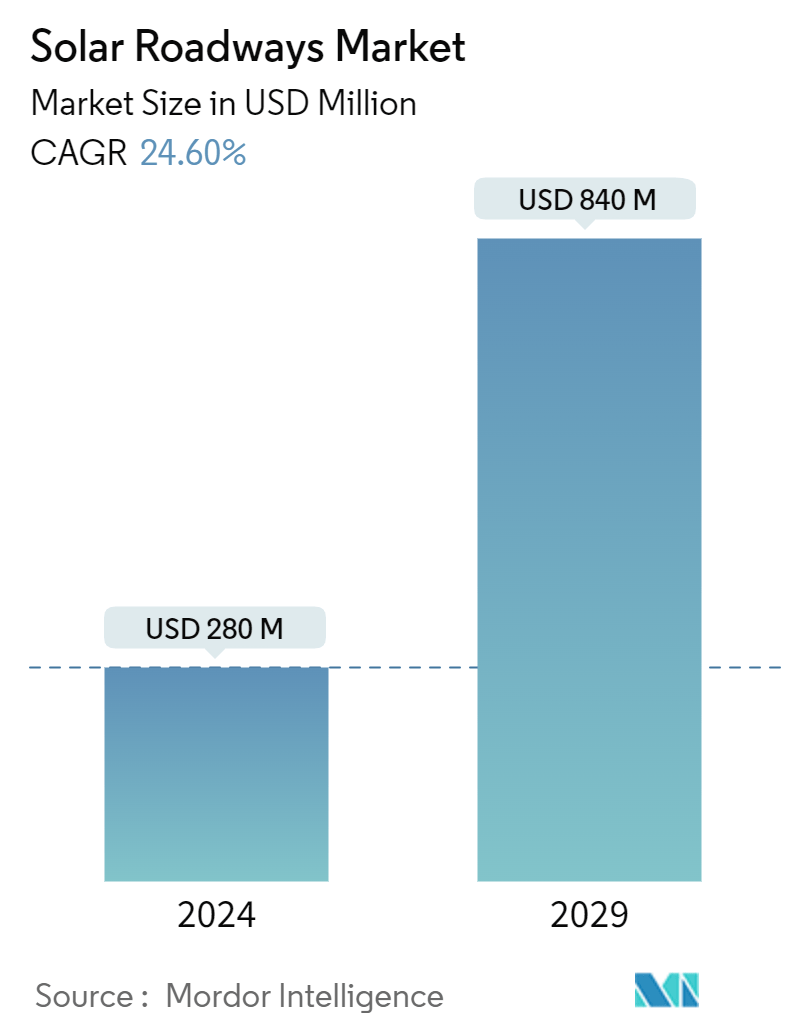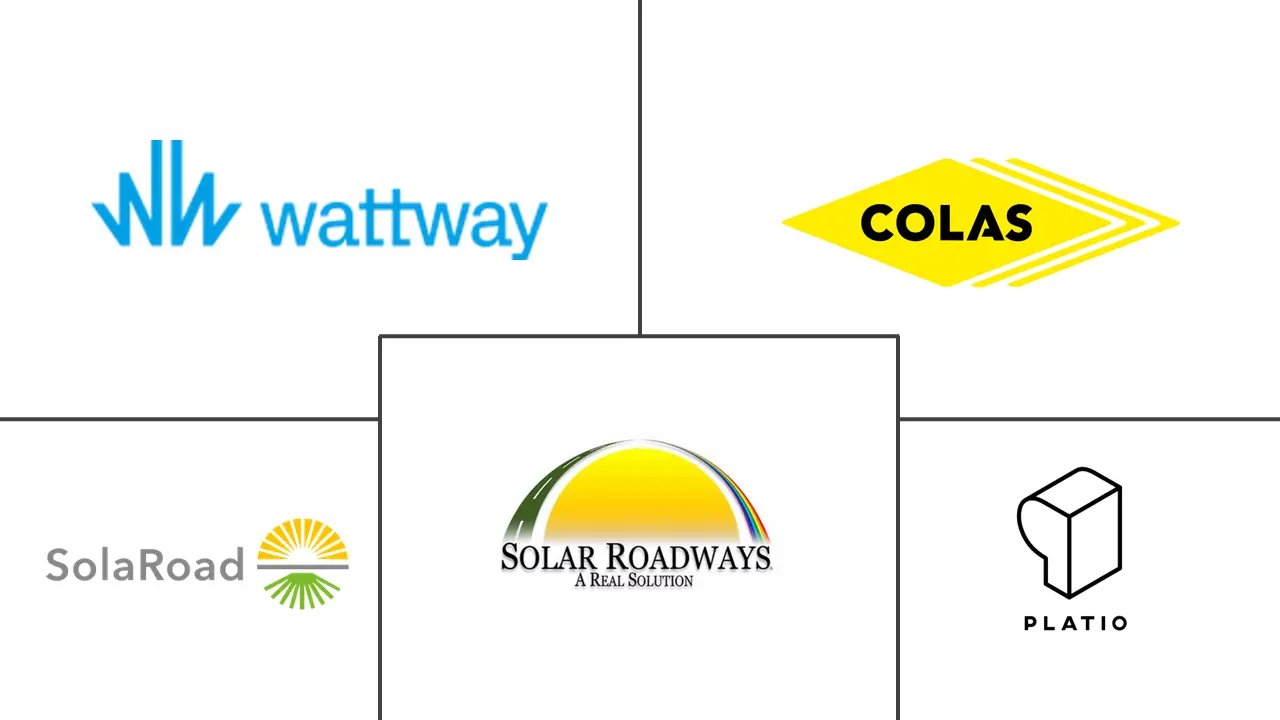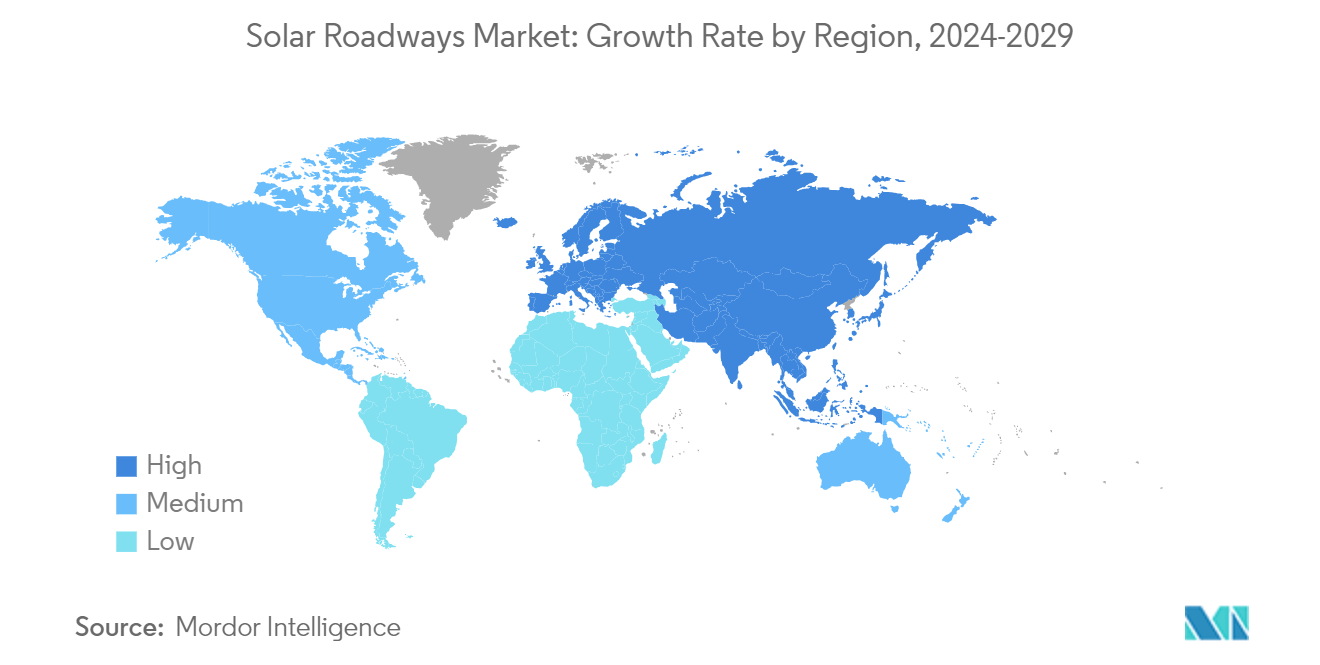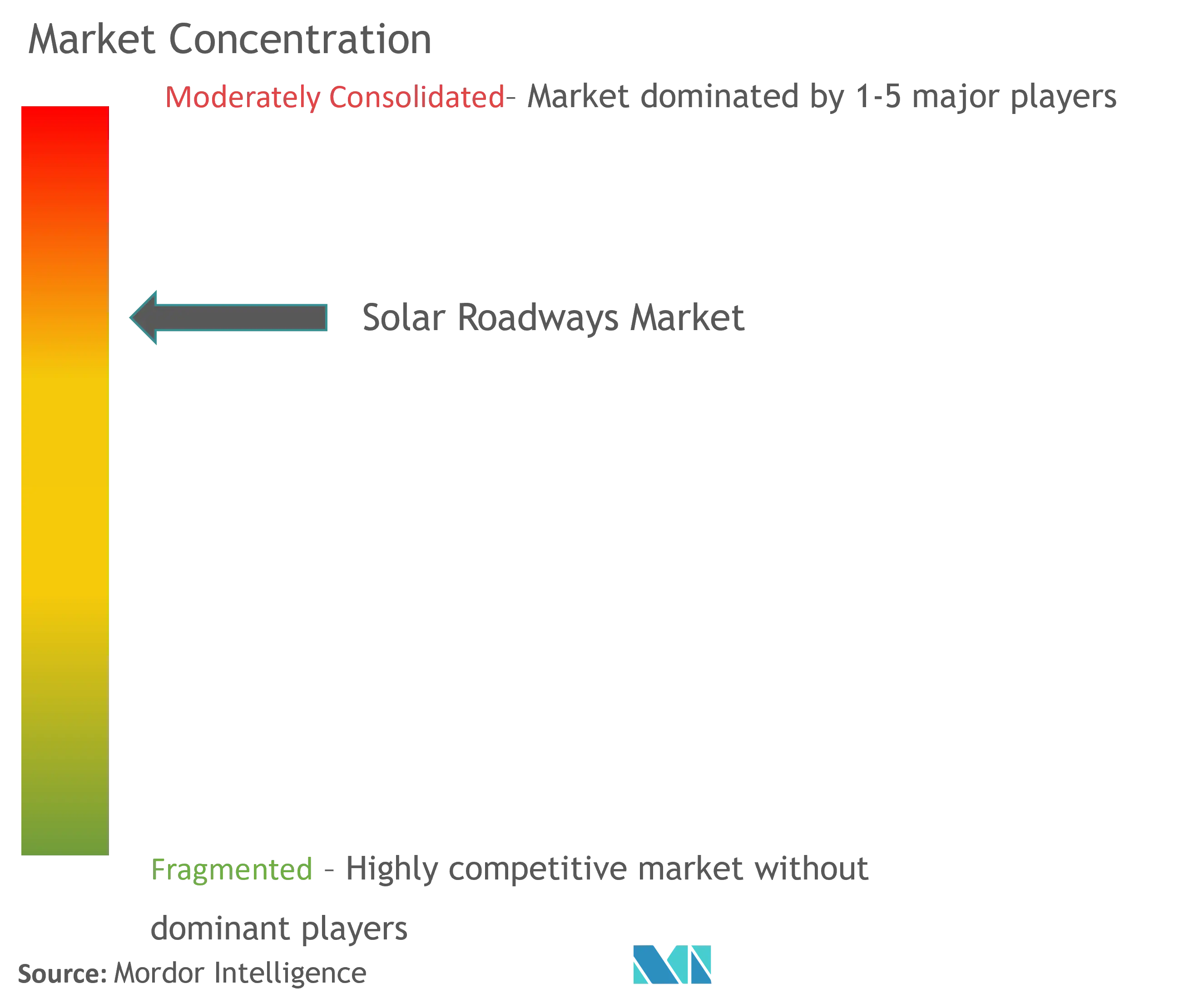Solar Roadways Market Size

| Study Period | 2019 - 2029 |
| Market Size (2024) | USD 280 Million |
| Market Size (2029) | USD 840 Million |
| CAGR (2024 - 2029) | 24.60 % |
| Fastest Growing Market | Asia Pacific |
| Largest Market | North America and Europe |
Major Players
*Disclaimer: Major Players sorted in no particular order |
Solar Roadways Market Analysis
The Solar Roadways Market size is estimated at USD 280 million in 2024, and is expected to reach USD 840 million by 2029, growing at a CAGR of 24.60% during the forecast period (2024-2029).
- Over the medium term, the growing adoption of renewable energy, increasing environmental concerns, and growing efforts in sustainable infrastructure to reduce carbon footprints are expected to drive the growth of the solar highways market.
- The high initial cost associated with developing the infrastructure, repairing the cost of the solar panels, and performance limitations-related challenges are expected to hinder market growth during the forecast period.
- Solar roadways can integrate wireless charging technology for electric vehicles (EVs), supporting the widespread adoption of clean transportation. EVs can be charged directly from solar-powered road surfaces, reducing the need for dedicated charging stations and extending their driving range. These are expected to hold vast opportunities in the future.
- Asia-Pacific is likely to witness considerable growth during the forecast period. The growth is a result of rapid urbanization, increasing energy demand, supportive government initiatives, advancements in solar technology, and sustainability priorities, which are likely to collectively propel it to become the fastest-growing region in the solar roads market.
Solar Roadways Market Trends
The Driveways Segment is Expected to Witness Significant Growth
- With the advancement of renewable energy technology, countries around the world are exploring several ways to integrate renewable energy, such as solar energy, on roads and highways. Installing solar panels on roads provides several advantages, like generating green electricity to power street lights and charge electric vehicles.
- There are several studies around the world that estimate the potential of solar energy on roads and rails. For instance, in March 2024, the European Commission's Joint Research Centre (JRC) found 403 GW of solar energy potential, which is estimated to have an annual energy production of around 391 TWh. Such a study is expected to support the segment to have investment for development in the upcoming years.
- Asia-Pacific is home to some of the world's most populous and traffic-congested cities, offering ample opportunities for solar highways to generate electricity and contribute to easing gridlock through smart transportation features, such as intelligent traffic management systems and electric vehicle charging stations integrated into the roads.
- The advancements in solar technology, including improved efficiency and durability of photovoltaic cells, are making solar highways more feasible and cost-effective than ever before. Collaborations between governments, technology companies, and infrastructure developers are driving innovation and scaling up deployment efforts across the region.
- For example, the first solar pavements in Singapore were planned to be installed on Sentosa's Fort Siloso Skywalk in the first quarter of 2024 as part of the island's efforts to achieve carbon neutrality while it explores new ways to harness the power of the sun. Solar pavements are essentially solar panels installed on pavements that pedestrians can walk on. The Sentosa Development Corporation (SDC) has been aggressively rolling out the use of solar panels. It achieved over 5.2 megawatt-peak solar capacity in 2023, surpassing its original 3 megawatt-peak solar capacity target by about 68%. SDC is actively collaborating with its island partners to roll out its solar panel. All these efforts are likely to see an increase in the growth of the solar roadways market in the coming years.
- Therefore, as per the points mentioned above, Asia-Pacific is expected to witness rapid growth during the forecast period.

Asia-Pacific will be the Fastest-Growing Region
- The Asia-Pacific region is witnessing a burgeoning interest and investment in solar highways, driven by the imperative to transition towards sustainable energy sources and mitigate environmental concerns.
- In recent years, the region has been rapidly prioritizing renewable energy initiatives to address energy security and climate change challenges. This has led to significant government support and initiatives related to solar highway projects, fostering a conducive environment for their development. For example, in 2022, as per the Road Transport and Highways Ministry in India, the country has been working on developing electric highways powered by solar energy that will facilitate the charging of heavy-duty trucks and buses. Such efforts will likely help the solar roadways market growth in the region.
- Further, the rapid urbanization and infrastructural expansion in countries like China and India have exacerbated energy demands, making innovative solutions like solar highways attractive for their potential to generate clean electricity while utilizing existing infrastructure.
- Moreover, the region is home to some of the world's most populous and traffic-congested cities, offering ample opportunities for solar highways to generate electricity and contribute to easing gridlock through smart transportation features such as intelligent traffic management systems and electric vehicle charging stations integrated into the roads.
- In addition, the advancements in solar technology, including improved efficiency and durability of photovoltaic cells, are making solar highways more feasible and cost-effective than ever before. Besides, collaborations between governments, technology companies, and infrastructure developers are driving innovation and scaling up deployment efforts across the region.
- For example, the first solar pavements in Singapore were planned to be installed on Sentosa's Fort Siloso Skywalk in the first quarter of 2024 as part of the island's efforts to achieve carbon neutrality while it explores new ways to harness the power of the sun. Solar pavements are essentially solar panels installed on pavements that pedestrians can walk on. Moreover, the Sentosa Development Corporation (SDC) has been aggressively rolling out the use of solar panels. It achieved over 5.2 megawatt-peak solar capacity in 2023, surpassing its original 3 megawatt-peak solar capacity target by about 68%. In addition, SDC is actively collaborating with its island partners to roll out its solar panel. All these efforts are likely to see an increase in the growth of the solar roadways market in the coming years.
- Therefore, as per the points mentioned above, the Asia-Pacific Region is expected to witness rapid growth during the forecast period.

Solar Roadways Industry Overview
The solar roadways market is semi-consolidated. Key players in this market include Solar Roadways, Wattway, Colas Group, SolaRoad Inc., and PLATIO Solar, among others.
Solar Roadways Market Leaders
-
Solar Roadways
-
Wattway
-
Colas Group
-
SolaRoad Inc.
-
PLATIO Solar
*Disclaimer: Major Players sorted in no particular order

Solar Roadways Market News
- May 2023: The Dutch province of North Brabant started constructing a 500-meter-long ground-mounted solar cycle path along the provincial N285 road near Wagenberg. The PV system will be integrated into the asphalt top layer and comprise 600 unspecified solar panels. As per the government, the project is mainly intended to gain experience deploying solar cells on bicycle paths. During five years, government experts will assess the resistance of the solar modules to the mechanical stress applied by the presence of pedestrians and bikers, the costs for their maintenance, and the PV system energy yield.
Solar Roadways Market Report - Table of Contents
1. INTRODUCTION
- 1.1 Scope of the Study
- 1.2 Market Definition
- 1.3 Study Assumptions
2. EXECUTIVE SUMMARY
3. RESEARCH METHODOLOGY
4. MARKET OVERVIEW
- 4.1 Introduction
- 4.2 Market Size and Demand Forecast in USD billion, till 2029
- 4.3 Recent Trends and Developments
- 4.4 Government Policies and Regulations
-
4.5 Market Dynamics
- 4.5.1 Drivers
- 4.5.1.1 Growing Adoption of Renewable Energy
- 4.5.1.2 Efforts in Sustainable Infrastructure to Reduce Carbon Footprints
- 4.5.2 Restraints
- 4.5.2.1 High Initial Cost Associated With Developing the Infrastructure
- 4.6 Supply Chain Analysis
-
4.7 Industry Attractiveness - Porter's Five Forces Analysis
- 4.7.1 Bargaining Power of Suppliers
- 4.7.2 Bargaining Power of Consumers
- 4.7.3 Threat of New Entrants
- 4.7.4 Threat of Substitutes Products and Services
- 4.7.5 Intensity of Competitive Rivalry
- 4.8 Investment Analysis
5. MARKET SEGMENTATION
-
5.1 Materials
- 5.1.1 Monocrystalline Silicon
- 5.1.2 Polycrystalline Silicon
-
5.2 Applications
- 5.2.1 Driveways
- 5.2.2 Parking Lots
-
5.3 Geography [Market Size and Demand Forecast till 2029 (for regions only)]
- 5.3.1 North America
- 5.3.1.1 United States
- 5.3.1.2 Canada
- 5.3.1.3 Rest of North America
- 5.3.2 Europe
- 5.3.2.1 Germany
- 5.3.2.2 France
- 5.3.2.3 United Kingdom
- 5.3.2.4 Italy
- 5.3.2.5 Spain
- 5.3.2.6 NORDIC
- 5.3.2.7 Turkey
- 5.3.2.8 Russia
- 5.3.2.9 Rest of Europe
- 5.3.3 Asia-Pacific
- 5.3.3.1 China
- 5.3.3.2 India
- 5.3.3.3 Japan
- 5.3.3.4 Malaysia
- 5.3.3.5 Thailand
- 5.3.3.6 Indonesia
- 5.3.3.7 Vietnam
- 5.3.3.8 Rest of Asia-Pacific
- 5.3.4 Middle East and Africa
- 5.3.4.1 Saudi Arabia
- 5.3.4.2 United Arab Emirates
- 5.3.4.3 South Africa
- 5.3.4.4 Qatar
- 5.3.4.5 Egypt
- 5.3.4.6 Nigeria
- 5.3.4.7 Rest of Middle East and Africa
- 5.3.5 South America
- 5.3.5.1 Brazil
- 5.3.5.2 Argentina
- 5.3.5.3 Colombia
- 5.3.5.4 Rest of South America
6. COMPETITIVE LANDSCAPE
- 6.1 Mergers and Acquisitions, Joint Ventures, Collaborations, and Agreements
- 6.2 Strategies Adopted by Leading Players
-
6.3 Company Profiles
- 6.3.1 Solar Roadways
- 6.3.2 Wattway
- 6.3.3 Colas Group
- 6.3.4 SolaRoad Inc.
- 6.3.5 PLATIO Solar
- 6.3.6 Onyx Solar Energy
- 6.3.7 Wuxi Suntech Power Co. Ltd
- 6.3.8 Canadian Solar
- *List Not Exhaustive
- 6.4 Market Ranking/Share (%) Analysis
- 6.5 List of Other Prominent Companies
7. MARKET OPPORTUNITIES AND FUTURE TRENDS
- 7.1 Solar Roadways Integrating Wireless Charging Technology for Electric Vehicles (EVs)
Solar Roadways Industry Segmentation
- Solar roadways, also known as solar pavements, refer to the concept of integrating solar panels and solar technology into highways, sidewalks, and other paved surfaces. They harness solar energy from the surface of roads and pavements to generate electricity, which is used to power streetlights, charge electric vehicles, and contribute to the energy grid. This promotes renewable energy adoption while addressing infrastructure needs and environmental concerns.
- The solar roadways market is segmented by material, application, and geography (North America, Europe, Asia-Pacific, South America, and Middle East and Africa). By material, the market is segmented into monocrystalline silicon and polycrystalline silicon. By application, the market is segmented into driveways and parking lots. The report also covers the market size and forecasts for the solar roadways market across major countries. Market sizing and forecasts were made for each segment based on revenue (USD).
| Materials | Monocrystalline Silicon | |
| Polycrystalline Silicon | ||
| Applications | Driveways | |
| Parking Lots | ||
| Geography [Market Size and Demand Forecast till 2029 (for regions only)] | North America | United States |
| Canada | ||
| Rest of North America | ||
| Geography [Market Size and Demand Forecast till 2029 (for regions only)] | Europe | Germany |
| France | ||
| United Kingdom | ||
| Italy | ||
| Spain | ||
| NORDIC | ||
| Turkey | ||
| Russia | ||
| Rest of Europe | ||
| Geography [Market Size and Demand Forecast till 2029 (for regions only)] | Asia-Pacific | China |
| India | ||
| Japan | ||
| Malaysia | ||
| Thailand | ||
| Indonesia | ||
| Vietnam | ||
| Rest of Asia-Pacific | ||
| Geography [Market Size and Demand Forecast till 2029 (for regions only)] | Middle East and Africa | Saudi Arabia |
| United Arab Emirates | ||
| South Africa | ||
| Qatar | ||
| Egypt | ||
| Nigeria | ||
| Rest of Middle East and Africa | ||
| Geography [Market Size and Demand Forecast till 2029 (for regions only)] | South America | Brazil |
| Argentina | ||
| Colombia | ||
| Rest of South America |
Solar Roadways Market Research FAQs
How big is the Solar Roadways Market?
The Solar Roadways Market size is expected to reach USD 280 million in 2024 and grow at a CAGR of 24.60% to reach USD 840 million by 2029.
What is the current Solar Roadways Market size?
In 2024, the Solar Roadways Market size is expected to reach USD 280 million.
Who are the key players in Solar Roadways Market?
Solar Roadways, Wattway, Colas Group, SolaRoad Inc. and PLATIO Solar are the major companies operating in the Solar Roadways Market.
Which is the fastest growing region in Solar Roadways Market?
Asia Pacific is estimated to grow at the highest CAGR over the forecast period (2024-2029).
Which region has the biggest share in Solar Roadways Market?
In 2024, the North America and Europe accounts for the largest market share in Solar Roadways Market.
What years does this Solar Roadways Market cover, and what was the market size in 2023?
In 2023, the Solar Roadways Market size was estimated at USD 211.12 million. The report covers the Solar Roadways Market historical market size for years: 2019, 2020, 2021, 2022 and 2023. The report also forecasts the Solar Roadways Market size for years: 2024, 2025, 2026, 2027, 2028 and 2029.
Solar Roadways Industry Report
Statistics for the 2024 Solar Roadways market share, size and revenue growth rate, created by Mordor Intelligence™ Industry Reports. Solar Roadways analysis includes a market forecast outlook for 2024 to 2029) and historical overview. Get a sample of this industry analysis as a free report PDF download.



